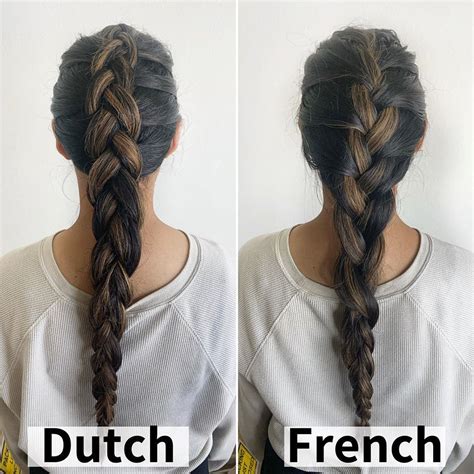Introduction
Braiding, an ancient art form, has become a staple in modern fashion, offering endless versatility and elegance. Among the most popular braiding techniques are the French braid and the Dutch braid. While both create stunning results, they differ in their construction, resulting in distinct aesthetics. This article delves into the intricacies of each technique, providing a comprehensive guide to help you achieve flawless braids.

Understanding the French Braid
The French braid, also known as the “outside-in” braid, is a classic and beloved technique. Its signature look is characterized by strands crossing over each other on the outside of the braid, creating a raised, intricate pattern.
How to French Braid: A Step-by-Step Approach
- Prepare your hair: Brush through your hair to remove any tangles or knots. Slightly dampen your hair for easier braiding.
- Create a base section: Separate a small section of hair from the top of your head.
- Start braiding: Cross the right strand over the middle strand. Then, cross the left strand over the new middle strand.
- Add hair: As you cross the strands, add a small section of hair from the side to the strand that is crossing over.
- Continue braiding: Repeat steps 3 and 4, adding hair as you go.
- Secure the braid: Once you reach the end of your hair, secure the braid with an elastic band.
Deciphering the Dutch Braid
The Dutch braid, also referred to as the “inside-out” braid, is a captivating variation of the French braid. In this technique, the strands cross under each other, creating a recessed, lace-like pattern.
How to Dutch Braid: A Step-by-Step Guide
- Prepare your hair: Follow the same preparation steps as for the French braid.
- Create a base section: Separate a small section of hair from the top of your head.
- Start braiding: Cross the right strand under the middle strand. Then, cross the left strand under the new middle strand.
- Add hair: As you cross the strands, add a small section of hair from the side to the strand that is crossing under.
- Continue braiding: Repeat steps 3 and 4, adding hair as you go.
- Secure the braid: Once you reach the end of your hair, secure the braid with an elastic band.
Comparative Analysis: French vs. Dutch Braid
| Feature | French Braid | Dutch Braid |
|---|---|---|
| Construction | Strands cross over each other | Strands cross under each other |
| Appearance | Raised, intricate pattern | Recessed, lace-like pattern |
| Complexity | Moderate | Slightly more challenging |
| Versatility | Suitable for various hair textures | Ideal for thick or wavy hair |
| Hair Length | Best for medium to long hair | Can be done with shorter hair |
Additional Tips and Considerations
- Practice makes perfect: Braiding takes practice to master. Don’t get discouraged if your first attempts aren’t flawless. Keep practicing and you’ll eventually get the hang of it.
- Use a mirror: Braiding can be tricky to do on yourself. Use a mirror to help you see what you’re doing and ensure that your braids are even.
- Secure the braids: Use hairspray or a setting spray to help keep your braids in place throughout the day.
- Accessorize: Add ribbons, beads, or other hair accessories to your braids to personalize them and create a unique look.
Frequently Asked Questions (FAQs)
Q1: Can I French braid my own hair?
A1: Yes, with practice, you can French braid your own hair.
Q2: Which braid is better for thick hair?
A2: A Dutch braid is better for thick or wavy hair as it helps keep the hair under control.
Q3: How long should my hair be for a Dutch braid?
A3: You can Dutch braid hair of any length. However, it’s easier to do a Dutch braid with longer hair.
Q4: What are some creative ways to use braids?
A4: Braids can be used to create various hairstyles, such as buns, updos, and crowns.
Conclusion
French and Dutch braids are versatile and stunning braiding techniques that can elevate any hairstyle. While the French braid offers a classic and intricate look, the Dutch braid creates a unique and eye-catching effect. By understanding the differences between these two techniques and mastering the steps involved, you can achieve flawless braids that will turn heads and leave a lasting impression.
